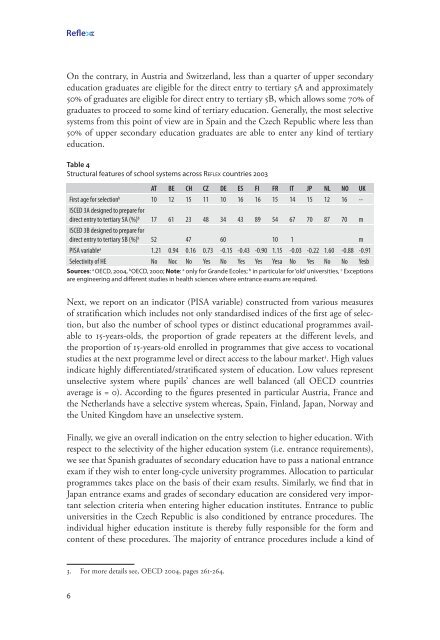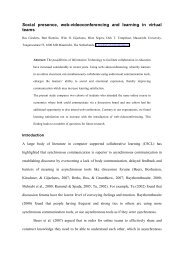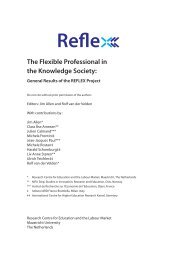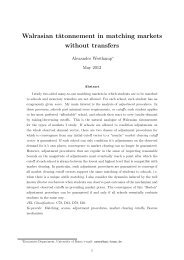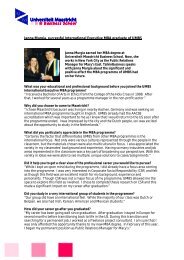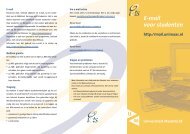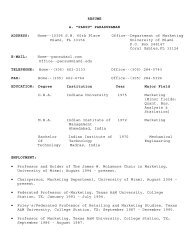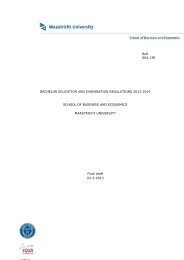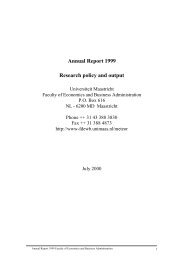Reflex Country study - School of Business and Economics ...
Reflex Country study - School of Business and Economics ...
Reflex Country study - School of Business and Economics ...
Create successful ePaper yourself
Turn your PDF publications into a flip-book with our unique Google optimized e-Paper software.
Ree<br />
On the contrary, in Austria <strong>and</strong> Switzerl<strong>and</strong>, less than a quarter <strong>of</strong> upper secondary<br />
education graduates are eligible for the direct entry to tertiary 5A <strong>and</strong> approximately<br />
50% <strong>of</strong> graduates are eligible for direct entry to tertiary 5B, which allows some 70% <strong>of</strong><br />
graduates to proceed to some kind <strong>of</strong> tertiary education. Generally, the most selective<br />
systems from this point <strong>of</strong> view are in Spain <strong>and</strong> the Czech Republic where less than<br />
50% <strong>of</strong> upper secondary education graduates are able to enter any kind <strong>of</strong> tertiary<br />
education.<br />
Table 4<br />
Structural features <strong>of</strong> school systems across <strong>Reflex</strong> countries 2003<br />
AT BE CH CZ DE ES FI FR IT JP NL NO UK<br />
First age for selection b 10 12 15 11 10 16 16 15 14 15 12 16 --<br />
ISCED 3A designed to prepare for<br />
direct entry to tertiary 5A (%) b 17 61 23 48 34 43 89 54 67 70 87 70 m<br />
ISCED 3B designed to prepare for<br />
direct entry to tertiary 5B (%) b 52 47 60 10 1 m<br />
PISA variable a 1.21 0.94 0.16 0.73 -0.15 -0.43 -0.90 1.15 -0.03 -0.22 1.60 -0.88 -0.91<br />
Selectivity <strong>of</strong> HE No Noc No Yes No Yes Yes Yesa No Yes No No Yesb<br />
Sources: a OECD, 2004, b OECD, 2000; Note: a only for Gr<strong>and</strong>e Ecoles; b in particular for ‘old’ universities, c Exceptions<br />
are engineering <strong>and</strong> different studies in health sciences where entrance exams are required.<br />
Next, we report on an indicator (PISA variable) constructed from various measures<br />
<strong>of</strong> stratification which includes not only st<strong>and</strong>ardised indices <strong>of</strong> the first age <strong>of</strong> selection,<br />
but also the number <strong>of</strong> school types or distinct educational programmes available<br />
to 5-years-olds, the proportion <strong>of</strong> grade repeaters at the different levels, <strong>and</strong><br />
the proportion <strong>of</strong> 5-years-old enrolled in programmes that give access to vocational<br />
studies at the next programme level or direct access to the labour market 3 . High values<br />
indicate highly differentiated/stratificated system <strong>of</strong> education. Low values represent<br />
unselective system where pupils’ chances are well balanced (all OECD countries<br />
average is = 0). According to the figures presented in particular Austria, France <strong>and</strong><br />
the Netherl<strong>and</strong>s have a selective system whereas, Spain, Finl<strong>and</strong>, Japan, Norway <strong>and</strong><br />
the United Kingdom have an unselective system.<br />
Finally, we give an overall indication on the entry selection to higher education. With<br />
respect to the selectivity <strong>of</strong> the higher education system (i.e. entrance requirements),<br />
we see that Spanish graduates <strong>of</strong> secondary education have to pass a national entrance<br />
exam if they wish to enter long-cycle university programmes. Allocation to particular<br />
programmes takes place on the basis <strong>of</strong> their exam results. Similarly, we find that in<br />
Japan entrance exams <strong>and</strong> grades <strong>of</strong> secondary education are considered very important<br />
selection criteria when entering higher education institutes. Entrance to public<br />
universities in the Czech Republic is also conditioned by entrance procedures. The<br />
individual higher education institute is thereby fully responsible for the form <strong>and</strong><br />
content <strong>of</strong> these procedures. The majority <strong>of</strong> entrance procedures include a kind <strong>of</strong><br />
3. For more details see, OECD 2004, pages 26 -264.


